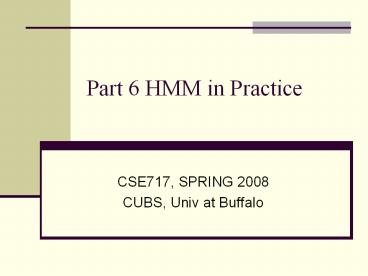Part 6 HMM in Practice - PowerPoint PPT Presentation
Title:
Part 6 HMM in Practice
Description:
... Tying Model Tying State Tying Mixture Tying Beam Search Although the Viterbi Algorithm has linear complexity ... Extraction Recognition n-gram ft ... – PowerPoint PPT presentation
Number of Views:110
Avg rating:3.0/5.0
Title: Part 6 HMM in Practice
1
Part 6 HMM in Practice
- CSE717, SPRING 2008
- CUBS, Univ at Buffalo
2
Practical Problems in the HMM
- Computation with Probabilities
- Configuration of HMM
- Robust Parameter Estimation (Feature
Optimization, Tying) - Efficient Model Evaluation (Beam Search, Pruning)
3
Dimension Reduction
- Curse of Dimensionality
- Principal Component Analysis (PCA)
- Linear Discriminative Analysis (LDA)
4
Tying
- Model Tying
- State Tying
- Mixture Tying
d o g
b a g
Feature vector clustering
Assign equal weight to every cluster
Fix and re-estimate weights of
mixtures using EM
5
Beam Search
- Although the Viterbi Algorithm has linear
complexity in the length of signal, it still has
quadratic complexity in the number of model
states. - Generic Viterbi
- Beam Search
the set of active state at time t
6
Part 7 System
- CSE717, SPRING 2008
- CUBS, Univ at Buffalo
7
A Handwriting Recognition System Using HMM
Sliding Window Features
Embedded Training
Char HMM
Word HMM
PCA/LDA (optional)
Char HMM
Word HMM
Training
Feature Extraction
Viterbi Decoding
Recognition
n-gram
8
Feature Extraction
- Divide the word image into vertical frames
- Each frame is further divided into a number of
cells - A fixed number of features are computed per cell
- Frame level feature vectors are treated as a
multivariate time series
ft
f1 f2
9
Embedded Training in The HMM
Features
Embedded Training
Char HMM
Word HMM
- Feature vectors are represented by Gaussian
Mixture Models (GMM) - Embedded training using the Baum-Welch algorithm
shared character HMMs are trained using word
images - Initialize character-level HMMs
- Make word-level composite HMMs by concatenating
character HMMs - Align training word images to word models
(Baum-Welch) - Re-estimate GMM and state transition of each
character HMM Go to step 3
10
Composite Word Model
d
o
g































